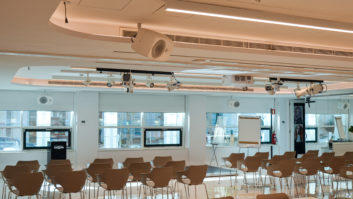
In the first part of our feature on medical AV, we heard about the impact of tight budgets on innovation, however availability of funds isn’t the only barrier. “The close relationship between higher education institutions and training and education in healthcare is helping to reduce fear in the introduction of technology,” Pure AV group sales manager Aidan Crowe explains. “As education and industry demonstrate the benefits that technology such as online streaming, remote and home conferencing and collaborative technologies bring to workflow, time and resource; healthcare organisations have witnessed this, and are ready to see how they too can deploy these solutions to be smarter and more efficient in their working practices.”
Kiran Sanghera, manager, product managers, VI [Visual Instruments] business at Epson, picks up on the theme of education and learning. “When training comes into the picture, the need to make learning as effective as possible is at the forefront of healthcare challenges,” she claims. “Better engagement with the learning audience, remote connectivity from different locations locally or on a global platform, collaborations during training sessions and making them interactive and easy to remember are all pivotal elements for successful teaching environments to help increase productivity and efficiency.”
NHSX focuses on interoperability, in which the network will play a vital role. Pierre Josling, marketing executive at RGB Communications, which represents Atlona in the UK, sees that as pivotal.
“Key to many AV installations in the healthcare market – now and in the future – will be enhancing and improving the network IT infrastructure,” he says. “So much of the new technology utilises a robust network – AV over IP, IP meeting spaces all require a reliable network. Part of this process is making sure that you bring on board the internal IT network team so that they feel comfortable with any new technology.”
Network interoperability is only one of the challenges that the NHS faces, however. “Another is the adoption of new technology once implemented,” says Crowe. “It’s crucial, in an environment in which every penny is hard won – often through charitable donation – that we help our healthcare clients realise a good return on investment. We achieve this through the design and delivery of solutions that are simple to use, ensuring that even the most complex of systems is designed with a user interface that encourages logical, straight forward usage and control. We work alongside staff responsible for the management of equipment to provide and develop training for both support staff and end users, and we ensure access to robust support mechanisms, so that should an issue occur, there is a quick and easy route to resolution.”
Benefits, not technology
Josling sees another. “It’s vital that those involved – and it applies to the healthcare market no less than to any other – focus on the benefits of any technology, rather than just on the technology itself,” he affirms. “As part of the tendering process, healthcare organisations need to have a focus on maximising the benefits – saving time, saving money, improving quality and so on.”
Epson’s Sanghera also sees the importance of time. “Time is definitely a scarce resource when it comes to healthcare: better care means dedicating more time to patients,” she says. “All our solutions are designed with this in mind: for example, we offer laser display solutions, which is our ‘fit and forget’ technology that eliminates the need for maintenance.”
It is, of course, early days for NHSX. Even so, it is perhaps startling that, thus far, there has been little – if any – mention of the role of suppliers in helping to set the direction (other than a passing reference to working with “the wider digital economy”). Given their knowledge of what’s possible and feasible, it’s surprising their involvement has not – at least yet – been solicited. So what would the AV industry say to those responsible for the design and delivery of NHSX?
Pure AV’s Crowe is clear. “Listen to the trusts and CCGs [Clinical Commissioning Groups], understand their challenges and work with them to create and provide clear guidance,” he declares. From a supply perspective, work with proven integrators and manufacturers. Don’t re-invent the wheel. The technology and experiences from other industries and market sectors in recent years all offer a source of learning and present clear examples of how and how not to use and deploy new technologies and services.”
Environmental impact
Sanghera turns to a theme that is increasingly preoccupying the AV industry. “It should be compulsory in any new framework that the focus is on environmental impact: all new adopted technology must demonstrate that its footprint is as low as possible,” she believes. “Meeting your sustainability targets through IT choices; saving on power; reducing waste; eliminating the need to manage complicated collection and recycling programmes; reducing your carbon footprint for logistics – all these elements should become an integral part of any new technology requirement.”
For Pure AV’s Crowe, NHSX is very much to be welcomed. “It sends a message that technology is to be embraced and encouraged. By bringing in teams and individuals from outside the traditional NHS sector, NHSX is giving itself every opportunity to be current, educated and at the forefront of technology use and deployment, instead of behind the curve. This will work well with the move to the cloud for wide area network communication delivered via the new HSCN (Health and Social Care Network). Already, we see trusts and organisations looking for ways to update from the traditional methods of communication and embracing technology; they should now have the support to deliver these changes in a structured way.”
“Of course,” he adds, “we need to wait and see whether the promise we see on paper translates through to real action on the ground.”
“NHSX has the potential to support, and perhaps accelerate, the activity we already see within cloud-based communication,” continues Crowe, “as the move from N3 [the NHS network from 2006] and HSCN [the Health and Social Care Network that was announced as replacing N3 in 2017] drives NHS bodies to take a refreshed approach to video and audio communications. We have already seen a change in direction from traditional videoconferencing networks and endpoint connections to solutions such as the StarLeaf Cloud for example, with its proven and secure interoperability with existing N3 network endpoints, new cloud-based and client services such as Skype, Teams, Zoom and so on.”
Virtual services
“NHSX initiatives also have the potential to open the door for widescale adoption of virtual clinics and other virtual services which at present trusts are experimenting with,” he goes on. “This will bring increased opportunity to engage in the development of patient-facing solutions alongside our current activity focused on the internal healthcare workplace in MDT [Multi-disciplinary Teams], clinical skills, training and administrative spaces.”
“In the last two to three years,” Crowe concludes, “we have seen double-digit growth in our revenue from within the healthcare sector and, despite continued pressure on NHS budgets, we expect to see continued demand for our services within the healthcare market.”
Sanghera too sees opportunities for her company. “We understand that one of the objectives for NHSX will be reforming procurement – helping the NHS buy the right technology through the application of new procurement frameworks that support these standards,” she says. “This will definitely benefit our business, as Epson is able to provide solutions to healthcare that allow staff to make patients their priority. Using the latest technology in displays, printing and scanning, healthcare providers can save crucial time, have fewer distractions when it comes to technical devices and dedicate more time to patients. These days, it’s all about seamless workflows, faster communication and quicker connectivity, which Epson can deliver on in today’s fast-paced working environments, as our devices are built around end-user usage scenarios and job efficiency.”
“The objective is clear,” she goes on. “It’s about promoting a better use of technology to save time for doctors and nurses that can be spent with patients. New attention to cost-effectiveness is also pivotal and will create new opportunities for every modern technology provider.”
Improve and modernise
“More and more public and private healthcare providers are facing the need to improve and modernise the solutions they offer to patients,” Sanghera concludes. “We are investing more resources to make Epson able to answer to those market needs, with dedicated internal staff and committed partners who allow us to expand our healthcare footprint.”
“Better use of technology saves time for doctors and nurses that can be spent with patients. This new focus on cost-effectiveness is also pivotal, and will create new opportunities for every modern technology provider.”
For Olivier Vanovermeire, chief medical officer, who acts as a consultant to Barco’s healthcare business, the ultimate objective could not be clearer. “With the aging population and the rising need for healthcare in developing countries, the healthcare market is still growing,” he says. “There are always budget restrictions, but the money will be spent more on tools, equipment and software that raise efficiency, increase quality – with the bottom line being improved patient care. Improved patient care is, and must be, the end goal.”
As AVIXA’s Brad Grimes noted at the outset: growth in the healthcare market is expected to out-strip growth in all the other markets that his organisation tracks.
“The healthcare market presents a great opportunity for professional AV,” echoes Grimes. “From telemedicine, to build outs of new types of healthcare facilities, to visualisation solutions that new and existing facilities require, there is growing demand for AV in healthcare. That said, healthcare is a unique market, much like government, with incumbent solution providers, industry-specific regulations, and other factors that AV integrators and technology managers need to understand and navigate if they’re to meet the demand that we see coming in that sector.”
Any kind of transformational initiative creates opportunities – and NHSX is unquestionably such an opportunity. AV manufacturers and integrators serving, or planning to serve, the healthcare market in the UK, as well as those responsible for managing in-house AV facilities in hospitals and surgeries around the country, will do well to heed Grimes’ advice as the impact of the NHSX initiative becomes increasingly felt.







